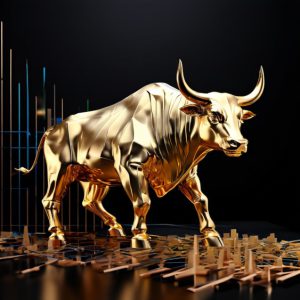
The Enigma of Market Psychology and Crowd Dynamics: Adapt, Adjust or Vanish
Updated May 04, 2024
In the ever-shifting tides of the financial markets, a profound truth echoes through the ages: “The crowd is untruth.” This timeless wisdom, imparted by the philosopher Søren Kierkegaard, encapsulates the essence of market psychology and crowd dynamics. In this realm, the masses often succumb to the allure of herd mentality, leaving those who dare to think independently to reap the rewards.
As legendary Benjamin Graham sagely observed, “The investor’s chief problem—and even his worst enemy—is likely to be himself.” This human element, the interplay of emotions, biases, and collective behaviour, shapes the ebb and flow of market trends, creating peril and opportunity for those who can decipher its intricate patterns.
Seizing Opportunity Amidst Chaos: Buying When Others Flee in Fear
In the markets, the wise investor recognizes that the greatest opportunities often arise when the crowd is gripped by fear and uncertainty. As the ancient Roman philosopher Seneca counselled, “It is in times of security that the spirit should be preparing itself for difficult times; while fortune is bestowing favours on it, it is then the time for it to be strengthened against her rebuffs.” While devastating to the unprepared, market crashes present an unparalleled opportunity for astute investors to acquire assets at deeply discounted prices.
The aftermath of the 2008-2009 financial crisis serves as a prime example. In the depths of that turmoil, when fear and panic gripped the masses, those with the fortitude to buy when others were selling were handsomely rewarded. A stealthy bull market emerged from the ashes, arguably lasting until the COVID-19 crash over a decade later. This extended period of growth underscores the immense potential of contrarian investing during market chaos.
Uncertainty, too, can be a powerful ally for the discerning investor. Asset prices often languish when the crowd lacks conviction and is paralyzed by indecision and doubt, creating opportunities for those who can see beyond the fog of uncertainty. As the philosopher Heraclitus observed, “No man ever steps in the same river twice, for it’s not the same river, and he’s not the same man.” In this ever-changing market landscape, embracing uncertainty and acting decisively can yield substantial rewards.
The key lies in recognizing that the crowd’s fear and uncertainty are often rooted in emotion rather than reason. While the masses flee at the first sign of trouble, the contrarian investor sees these moments as potential entry points, opportunities to acquire undervalued assets that the herd has discarded in its panic. By maintaining a disciplined, rational approach and resisting the siren call of herd mentality, the wise investor can capitalize on the crowd’s missteps and forge a path to enduring success.
Unraveling the Tapestry of Mass Psychology
“The crowd is untruth,” echoed the ancient philosopher, a sentiment that resonates profoundly in market psychology. For it is in the collective consciousness of the masses that the seeds of irrational exuberance and unfounded fear take root, driving asset prices to dizzying heights or plunging them into the depths of despair. This herd mentality, fueled by emotion rather than reason, can create distortions in the market that defy fundamental analysis and rational valuation models.
Yet, within this chaos lies a hidden order, a tapestry woven by the threads of human emotion and behaviour. The ability to decipher these intricate patterns separates the truly successful investors from the rest of the herd. To unravel the mysteries of mass psychology, one must embrace the teachings of the sages, those who have mastered the art of deciphering the crowd’s ebb and flow.
At the heart of this endeavour lies the recognition that markets are not merely driven by cold, hard data but by the complex interplay of human emotions, biases, and collective behaviour. Fear, greed, overconfidence, and herd instinct all shape market trends, creating opportunities for those who can maintain a rational, disciplined approach amidst the chaos.
By studying the patterns that emerge from this tapestry of mass psychology, the astute investor can anticipate shifts in sentiment, identifying potential turning points before the crowd has had a chance to react. This foresight and the courage to act against the prevailing tide can unlock significant rewards in an environment where emotion and short-term thinking often sway the masses.
The Contrarian’s Edge: Defying the Herd
“Be fearful when others are greedy, and greedy when others are fearful,” counselled the Oracle of Omaha, Warren Buffett, a mantra that encapsulates the essence of contrarian investing, for it is in the moments when the crowd is consumed by euphoria or paralyzed by the dread that the actual opportunities emerge, like diamonds forged in the crucible of market turmoil.
Armed with a deep understanding of market psychology and crowd dynamics, the contrarian investor dares to tread where others fear to venture. They recognize that the masses are often swayed by emotion, chasing the latest fad or fleeing at the first sign of trouble, leaving undervalued assets in their wake.
A prime example is the dot-com boom of the late 1990s. While the investing public piled into hot internet stocks with reckless abandon, contrarians like Bill Miller’s Legg Mason Value Trust fund took the opposite stance. As the mania reached a fever pitch in 1999, Miller added beaten-down bellwethers like Dell and Amazon to his portfolio at bargain valuations. His unwavering discipline allowed him to realize immense gains when the inevitable bust unfolded, cementing his status as a legendary value investor. The dot-com craze epitomized the perils of following the crowd versus adopting a contrarian, research-driven approach.
Technical Analysis: Unveiling the Market’s Heartbeat
Yet, to truly harness the power of market psychology and crowd dynamics, one must also embrace the art of technical analysis. As the legendary trader Jesse Livermore once quipped, “The sitting, not the trading, makes the money.”
The technical analysis unveils the market’s heartbeat, revealing the intricate patterns and trends that emerge from the collective behaviour of market participants. By studying these patterns, the astute investor can anticipate shifts in sentiment, identifying potential turning points before the crowd has had a chance to react.
John Murphy, author of the seminal text Technical Analysis of the Financial Markets, emphasizes that “Charting is a study of the crowd psychology.” Monitoring indicators like price patterns, trading volume, momentum oscillators, and moving averages provides a quantitative lens into the battle between bulls and bears. Legendary technicians like John Bollinger, developer of Bollinger Bands, have demonstrated how combining volatility analysis with classical charting tools can pinpoint when the crowd has become overly complacent or fearful.
At its core, technical analysis represents the footprints of the crowd’s shifting psychology. As trader Brian Shannon states, “The charts tell the truth. They show the real-money sentiment.” By mastering this visual language of the markets, the diligent technician can stay ahead of the herd and capitalize on their emotional extremes.
The Sage’s Wisdom: Embracing Uncertainty, Seizing Opportunity
Uncertainty is the only constant in the market’s ever-changing landscape. As the philosopher Heraclitus observed, “No man ever steps in the same river twice, for it’s not the same river, and he’s not the same man.”
In this crucible of uncertainty, the true masters of market psychology and crowd dynamics thrive. They embrace the chaos, recognizing that within the turmoil lie the most significant opportunities for those with the wisdom and fortitude to seize them.
As the ancient Chinese strategist Sun Tzu taught, “Amid the chaos, there is also opportunity.” The sage investor harnesses this chaos, born of the crowd’s irrational exuberance and unfounded fear, capitalizing on the masses’ missteps to forge their path to enduring success.
Ignite Your Intellect: Dive In!

Timeless Fortune: Exploring How Savings Bonds Operate After 30 Years

Decoding the Mystery: Where have bonds been when the stock market crashes?

The Ebb and Flow of Investor Sentiment: Bull, Bear and Stock Market Crashes

What are the three investments one can make to beat inflation?

US Stock Market Crash Date: Experts Discuss, But Where’s The Action?

Unlocking the Benefits of Investing in Precious Metal Stocks

Mastering Emotional Control for Successful Stock Market Investing

Preferred Stock Market Valuation Is Based Primarily Upon

Mastering Options Trading: Unveiling the Real Secrets

Which of the Following Is an Example of Collective Behavior?

4X ETF: Deadly Risks and Realities

SPY 200-Day Moving Average Strategy: Learn, Earn, and Prosper

Best Tech Stocks To Buy Now: Spotting the Trend

CPNG Share Price: Buy, Sell, or Hold?

Rolling Over Options: The Ultimate Guide to Mastery


